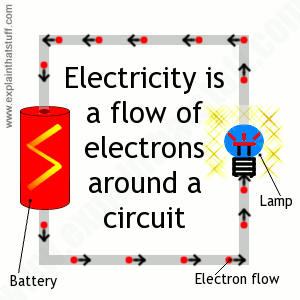What is Induced Current? Electricity being the
flow of moving electrons, it should be known this
produces a resultant called electrical current. This
current allows objects to work in tangent with each
other by flowing through conducting materials connecting
them. The path that the electrons flow through is called
a circuit. Circuits connect all of our electronic
devices allowing us to live the way we do today. Courtesy of http://www.explainthatstuff.com/electricity.html A current can be induced in a conducting loop if it is exposed to a changing magnetic field. This change may be produced in several ways; you can change the strength of the magnetic field, move the conductor in and out of the field, alter the distance between a magnet and the conductor, or change the area of a loop located in a stable magnetic field. No matter how the variation is achieved, the result, an induced current, is the same. The strength of the current will vary in proportion to the change of magnetic flux, as proven by Faraday's law of Induction. |
Faraday's Law can be described as the change in magnetic flux in a loop. From this concept many other factors can be discovered. Characteristics in the magnetic flux have been proven to be related to electricity and magnetism. Faraday's law says that When you have a change in magnetic flux you have a direct correlation to the direction of its induced current and magnetic field direction. This can be later described in more detail with the introduction of Lenz’s Law.
Electromagnetic
Induction
The relationship between the rate of change of the magnetic flux through a loop and the electro-motive force (EMF) is given by this equation. This describes all the factors going into what makes Faraday's law. The electric field, magnetic field, Flux and current directions are all related and can be described by simply manipulating this equation. There are many other equations to describe different aspects in more detail, this is very generic. |
Faraday's First Law: Any change in the magnetic field of a coil of wire will cause an emf to be induced in the coil. This emf induced is called induced emf and if the conductor circuit is closed, the current will also circulate through the circuit and this current is called induced current. Method to change magnetic field: By moving a magnet towards or away from the coil By moving the coil into or out of the magnetic field. By changing the area of a coil placed in the magnetic field By rotating the coil relative to the magnet. Faraday's Second Law: It states that the magnitude of emf induced in the coil is equal to the rate of change of flux that linkages with the coil. The flux linkage of the coil is the product of number of turns in the coil and flux associated with the coil. Illustration by --> http://www.physicsclassroom.com/class/circuits/Lesson-2/What-is-an-Electric-Circuit  & flow of charge
 The gif above
illustrates the direction the flow would move, and how
the charges would be used up over time. You can see
that the positive charges are attracted towards the
negative charges. The overall charge of the system
would be used up over time because the circuit is not
in a closed loop, so the energy isn't conserved.
|
| |